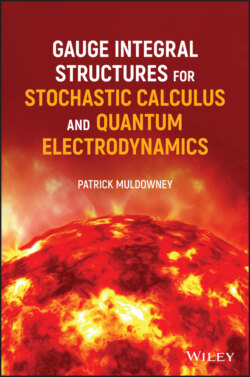Читать книгу Gauge Integral Structures for Stochastic Calculus and Quantum Electrodynamics - Patrick Muldowney - Страница 14
Chapter 1 Stochastic Integration
ОглавлениеThe idea or purpose of stochastic integration is to define a random variable
where is a random or unpredictable quantity, depending in a particular manner on unpredictable entities and ; and where
are stochastic processes and depends on time t. In textbooks, the integrand is usually presented as , but is used here in order to emphasise that the integrand is intended to be random.
The integrand (or, when appropriate, ) is to be regarded as a measurable function—as is —with respect to a probability space .
If is a deterministic or non‐random function of s, its value at time s is a definite (non‐random) number which, whenever necessary, can be regarded as a degenerate random variable. If is the same random variable for each s in , each j, then the process is a step function. (In textbooks, the term elementary function is often applied to this.)
The most important kind of stochastic integral is where , is standard Brownian motion, and this particular case (called the Itô integral) is outlined here. The main steps are as follows.
I1 Suppose the integrand is a step function, with constant random variable value for , . Then defineIn this case (that is, a step function), the Itô isometry holds for expected values:
I2 Suppose the process (not necessarily a step function) satisfiesThen there exists a sequence of step functions (processes) , such that
I3 For such , define its stochastic integral with respect to the process as
I4 If is Brownian motion the latter limit exists.
An objective of this book is to provide an alternative to the classical theory, not develop it. Thus the commentary, interpretation, and speculation of this section can be safely omitted by anybody who is either already familiar with, or is not interested in, the standard theory of stochastic integration.
Regarding notation, many textbooks use the symbol B for Brownian motion, whereas is used above. Textbooks also use the symbol for the integrand, where is used above. The reason for using notation instead of ) is to emphasise that the value of the integrand function is generally a random variable depending on s, and not generally a single, definite real or complex number (such as the deterministic function , for instance) of the kind which occurs in ordinary integration.
In classical probability theory, an underlying mathematical probability measure space is assumed, such that, for all random variables and processes, the probability that any random variable has an outcome in a particular set can be calculated using the appropriate technical calculation1 relevant to each random variable. If the random variables or processes have a time structure, then mathematical properties of filtration and adaptedness ensure that sets A which qualify as ‐measurable events at earlier times will still qualify as such at subsequent times.
The integrator is a random variable. The integrand function or is also a random variable. And the (stochastic) integral , is a random variable. This point is sometimes illustrated in textbooks by means of examples such as the following.
